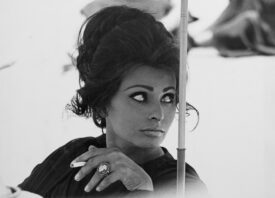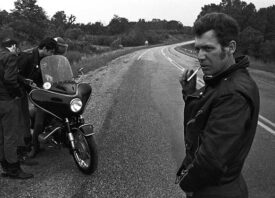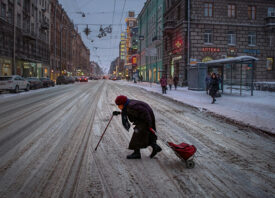Search this site
Behold The Astonishing Load-Carrying Motorbikes Of Vietnam



Hans Kemp first traveled to Vietnam in 1991, while working as a freelance photographer based in Hong Kong. “It was just before Tet, the Vietnamese (Lunar) New Year,” he remembers. “I landed in Ho Chi Minh City (formerly Saigon), and, on the way downtown from the airport in an ancient beat-up Renault Dauphine taxi, I felt an incredible rush. People were out on the streets en masse, doing their shopping for the festival. I checked into a hotel on Nguyen Hue Street, as central as you could be, and then I went out onto the pavement.
“I couldn’t believe my eyes. There was an incessant stream of motorbikes on the road in front of me. I mean dense, thousands. People were all dressed up, entire families on a bike, guys in suits, girls dolled up. I stood there mesmerized, intoxicated by this all-permeating scent of petrol mixed with perfume, sound, color, motion. There was an incredible vibrancy to it all. I felt I’d come to the right place.”
Four years later, he relocated to Vietnam. Then, in 2000, a client came to him with an idea that would follow him for decades: could he photograph the motorbikes that coursed through the city, each carrying impossible loads of produce and other wares? He hadn’t previously given much thought to the motorbikes, as they played such an integral role in the everyday fabric of the city where he lived, but after that serendipitous assignment, he was hooked. From there, he continued documenting the motorbikes–on his own time.
“The Vietnamese economy throughout the nineties and into the 21st century consisted (and still to a large extent does) mostly of countless small businesses,” Kemp explains. “Little mom and pop shops, grocery stores, market stalls, and so on. Add to that the Vietnamese insistence on fresh ingredients for every meal, a large urban population density, narrow streets, a low level of disposable income, and relatively affordable motorbikes available in the market. To get around the cities quickly and efficiently, deliver goods and produce multiple times a day, the only option is the motorbike.
“Cars are expensive, and though they can carry more, they would get stuck in traffic. There would be no parking space, and people wouldn’t be able to store large amounts of produce.” As the artist explains, many drivers were also paid by the load, encouraging these dizzying arrays of fruits, baskets, beer, meat, and even living animals.
Kemp rode mostly with Mr. Minh, an experienced motorbike taxi driver capable of keeping them safe while also chasing down the most interesting bikes as they passed. “Motorbike taxis in Vietnamese are called Xe Om. This literally means vehicle hugging,” he tells me now. “I was riding pillion, and we would hit the streets. Just cruising and spotting. And then when we saw a bike, we would do a u-turn, catch up with the bike, and I would try to photograph it while driving parallel at high speed.
“Standing on a street corner was not an option. Maybe you’d get a few lucky shots at best. And so we went on, zig-zagging throughout the city, following whatever amazing load we could. This went on for days, weeks, months. I spent hundreds of hours on the back of bikes. I got to know the city grid really well–and got to know the meaning of ‘pain in the butt’ too.”
By 2005, Kemp’s book Bikes of Burden had reached a worldwide audience. For many, it represented a collective striving for a better life–a will and determination that felt unique to Vietnam. “In a speech on US-Vietnam trade relations, ranking member of the Senate Finance Committee, Senator Max Baucus, used the book as a prime example of why Vietnam deserved Permanent Normal Trade Relations,” the photographer remembers. “That was a proud moment in the history of the series: Bikes of Burden as international policymaker. Two years later, Vietnam got the special trade status.”
Three decades since he first traveled to Ho Chi Minh City, Kemp ushered in a new chapter in the life of Bikes of Burden, releasing a collection of 130 photographs as non-fungible tokens. During the pandemic, the photographer, who has spent a lifetime on the road, found himself unable to travel. By the spring of 2021, a friend had told him about the emerging crypto art space.
“I had absolutely no idea what NFTs were–even what the acronym stood for,” he admits. “But after my initial reading up, I dived right into the deep end, because I realized the potential for artists like myself to find a new source of income, where the old model of physical book sales and agency sales was definitely on the way out. For the first time in a long time, I saw the emergence of a new artist/photographer – collector/customer paradigm. I knew I had to embrace it with my full, undivided attention in order to emerge successfully. Bikes of Burden was the obvious choice for the first collection.”
For Kemp, the photographs capture a time and place that, at least in some ways, no longer exists. “Vietnam has undergone tremendous economic changes in a short period of time,” he says. “Streets in the major cities are widened, the overall living conditions have improved, people have more disposable income, and less time to go shopping for fresh produce.
“Public transport infrastructure is still poor, so to get around, there are not many options. The bike certainly is still the best way to go and visit your friends, go on a night out, etc. But bike as carrier of goods, especially in the main urban areas, is becoming rarer, certainly for the larger and more risky loads. So this whole series really will become a historical testament to the ingenuity and willpower of the Vietnamese people.”

Minting the collection on the blockchain was a way of preserving the past–and bringing it into the future. Originally created on color slide film, the photographs now live on the blockchain, existing in the metaverse as well as the real world. If Bikes of Burden is an ode to a Vietnam that once was, it’s also a promise for what’s to come. And like all of the load-bearing motorbike drivers navigating the streets of Ho Chi Minh City, Kemp is looking back and forward at the same time. “One of my favorite images is this giant mirror being transported,” the artist tells me. “The traffic reflected in the mirror, and thus going the ‘other way,’ gives it a surreal feel.”








All images © Hans Kemp. You can follow the artist on Twitter at @lightchronicler. Browse his NFT collections on OpenSea and Foundation.



